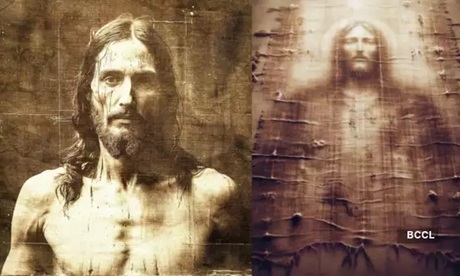A recent AI-generated image of the Shroud of Turin shows a wide-eyed man gazing straight at the viewer. Long narrow marks, as though from bleeding cuts, stream down his face and upper torso.
His hair is long, his beard trim.
This is the latest in numerous attempts since the 19th century to draw the authentic face of Christ from the Shroud that many believe is the cloth that covered his body after the Crucifixion.
It was then that what had always been thought to be scorch marks on the fabric were revealed by negative photographic images to be the imprinted figure of an injured man.
The roughly 1.8-metre ghostly figure is marked by wounds that correspond with those of Jesus mentioned in the Bible. They include thorn marks on the head, lacerations on the back and bruises on the shoulders.
Authenticity from AI
Could modern technology in the form of artificial intelligence (AI) really fill in the gaps for us that the Shroud so tantalisingly and controversially suggests, giving us a glimpse of Christ himself?
Sweat and blood imprint the fabric that – if proved authentic – bears the image of Christ’s face and body.
Sceptics argue the four-metre length of cloth is a medieval Italian hoax dating back to 1350. There are also rumours that it could have originated in Constantinople (now Istanbul) a century earlier.
New technology, however, has convinced Italian scientists examining the cloth that it could have originated in the Middle East and is about 2000 years old.
Hi-tech check
Italian scientist Dr Liberato de Caro used new technology known as Wide-Angle X-ray Scattering to examine the shroud’s fabric. He compared it with a sample of a similar age retained from the Masada siege in 55-74 AD.
The technique measures the natural aging of flax cellulose and works out how long ago it was made.
He and his team studied eight small samples of fabric from the Shroud, uncovering tiny details of the linen’s structure and cellulose patterns.
This, along with other specific aging parameters including temperature and humidity, enabled them to work out the fabric’s age.
His findings cast doubt on previous carbon dating he said.
“Moulds and bacteria… can be so difficult to completely eliminate in the sample cleaning phase – which can distort the dating.
”If the cleaning procedure of the sample is not thoroughly performed, carbon-14 dating [such as that used in 1988] is not reliable” he says.
De Caro says he also found a number of pollen grains from plants native to the Middle East embedded in the linen, which he says belies the idea that it is a European hoax.
His team also compared the Shroud with samples from linens manufactured between 1260 and 1390 AD. None was a match, reports say.
As Wide-Angle X-ray Scattering will not damage the Shroud sample, de Caro is hopeful others will be interested in checking and backing his findings.
Source
Additional readingNews category: Great reads, World.




